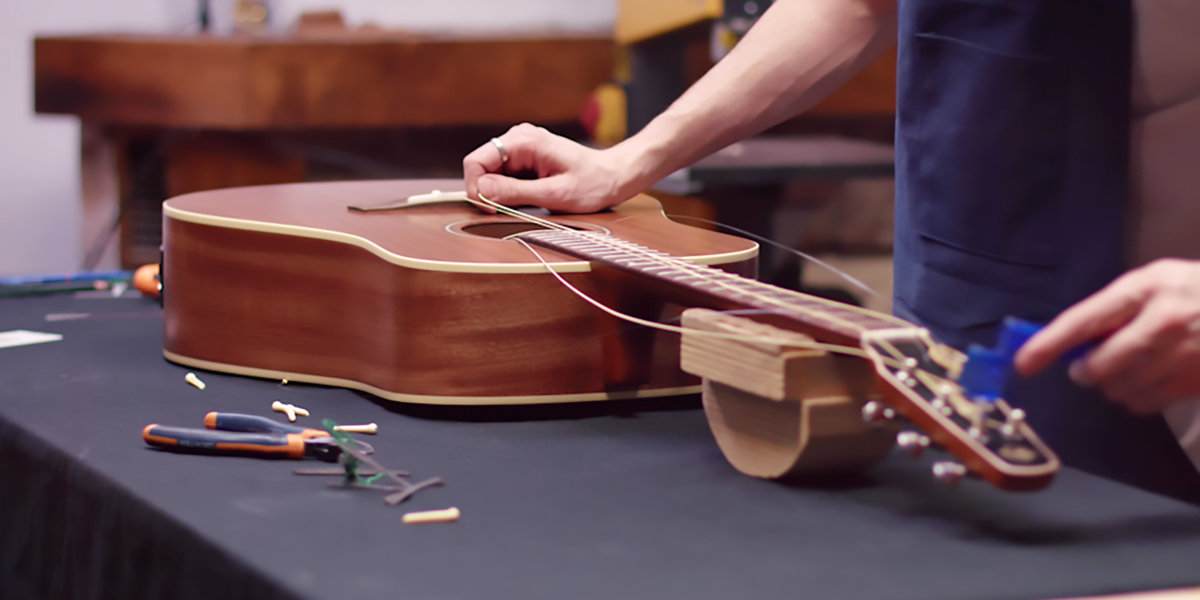How to Change Guitar Strings: A Complete Guide

When is the right time to change guitar strings? How’s it done? This article teaches you everything you need to know about replacing your guitar strings.
Creating delightful reverberations takes more than passion and practice. Your instrument also needs some tender love and care. You could be among the finest musicians to walk the earth, but if you treat your instrument like crap, it’ll sound like it too.
Maintaining and cleaning your guitar is essential to keep it working well and sounding pleasant.
Here’s everything you need to know about how to change guitar strings.
4 reasons to change guitar strings.
Before you change guitar strings, you must know when it’s necessary.
1. Wear and tear.
With time and use, the strings accumulate oils, dead skin, and debris and become weaker and wear out.
2. Your guitar string breaks.
Whether playing them too long or shredding too hard, your string can break under pressure.
3. Play style.
You may want to change the gauge or type of strings you use depending on the style of music you play.
4. Upgrading your strings.
Depending on your current set, you may want to try a new string type.
How often should you change guitar strings?
It depends on how often you play your guitar and how quickly the strings start to sound dull.
If you play your guitar every day, you may need to change your strings every few weeks. If you don’t play as often, you can probably get away with changing them every three months.
It also comes down to your budget and preference. If you need to play on crisp strings at all times, you’ll be changing your strings more often. On the other hand, you can always wait until you need to change them.
A good rule of thumb is to change your strings every 100 hours of playing or every three months. Exposure to the elements degrades your strings even if you’re not playing your instrument.
Assemble your tools.
Before replacing the strings, a few tools make changing them much easier.
To smoothen the process, get your hands on some:
- Wire cutters
- String winder
- Pliers (optional)
- Neck Support
- Strings
Finding some space in a quiet room is helpful too. It’s easier to stay organized and keep track of everything.
How to replace strings on a guitar.
Now that you’ve got your strings and tools nearby and quiet space, it’s time to replace your strings.
For this section, we refer to specific guitar parts. If you’re unfamiliar with the terms we’re using –bring yourself up to speed by reading our blog—Guitar Anatomy: What are the parts of a guitar?
Phase 1: String removal

Start by setting your guitar down and use the neck support to stabilize your guitar. You can use an actual guitar neck holder or a makeshift one if you’re supporting it.
Now it’s time to remove the strings. You can either undo all the strings or replace them one at a time. Some rumors say that removing all strings at once can damage your guitar’s neck–but it’s unlikely.
To remove your strings, using your string winder, loosen the tuning pegs on the headstock of your guitar. Once you notice the tension diminish in your string, you can cut the wire.
Use a set of pliers or the string winder (many come with a built-in notch), carefully remove the bridge pin and string from the body, and unwind the strings from the tuning peg.
Note–instead of bridge pins, electric guitars have a tailpiece. After unwinding and removing the string from the tuning peg, pull the wire out of the tailpiece instead of removing a bridge peg.
Phase 2: Attaching the new string

Now that the string is out, it’s time to thread the new one through the bridge of your guitar.
Insert the ball end of the string and pin it into the body. Pins usually have a cutout that snuggly locks the string in. Pull up on the slack when inserting the pin.
For electric guitars, you just feed the wire through the tailpiece.
Now you can attach the string to the machine head. Thread the string through the tuning peg from the middle of the headstock outwards.
At this point, there are two approaches to take. Some people cut and hold the string down to wind it, while others prefer to bend the string around the pin to keep it in place.
Start tightening the string. However, ensure the string winds underneath the excess wire–this all positions it better along the fretboard.
Lastly, cut the excess string off the tuning pegs.
Phase 3: Tune your guitar

Once you successfully change your strings, it’s time to tune them.
Guitarists with more experience can tune their instruments by ear. However, if you’re a beginner, we recommend using a tuner.
There are tons of options when it comes to tuners. Simply Tune is the perfect tool if you’re looking for a quality tuner that’s convenient and easy to use. The chromatic tuning app is free and has no ads, allowing you to get your guitar sounding right quickly and effectively.
String along.
Being proficient with your instrument goes beyond just playing it.
Changing your guitar strings is an essential aspect of caring for your instrument. Learning about the types of strings and how to install them expands your understanding of sounds, music, and the guitar itself.
It keeps your instrument sounding crisp—another skill to add to your repertoire. If you want to learn more skills, the Simply Guitar app is your fully-loaded pocket-sized guitar teacher.









